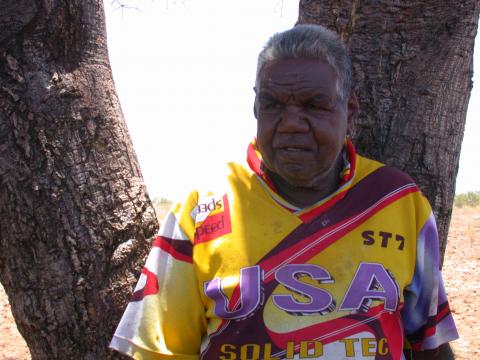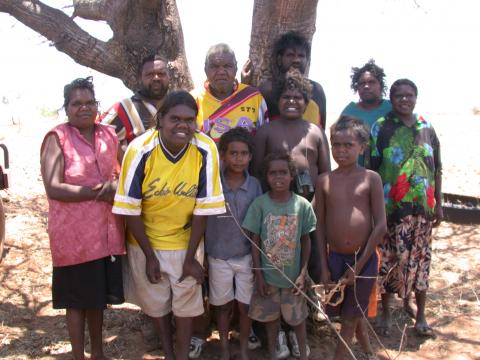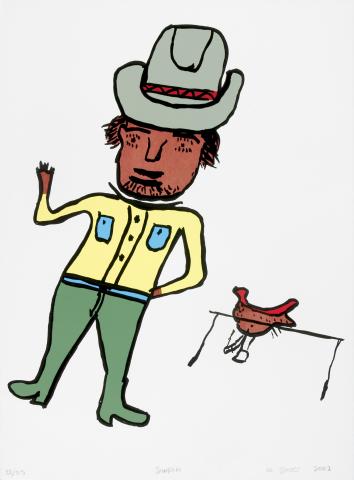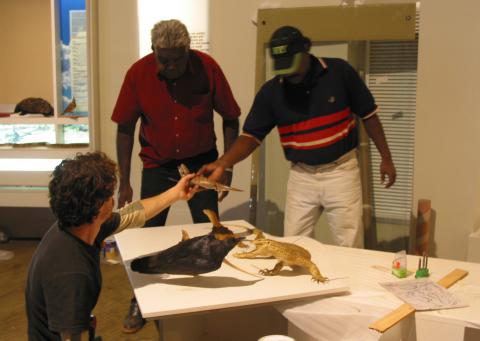Michael Jampin Jones
Jampin’s Life Story
Told by M. Jampin Jones
My Family
My name is Michael Jones. I was born on 13 September 1948 at Seven Mile Station. I am the second son of Alec Jangala and Polly Nungurayi and brother of Marleen Joy and Gordon (dec), and Gladys [dec].
My Mother and her sister was Warlpiri tribe from Willowara. Whitefellers was shooting Warlpiri people at and around Willowra Station. My Mother and her sister both ran away from these whitefellers. Both sisters left behind kids. My mother left behind my brother and two sisters, they passed away now. Only one of my sisters is alive now. My mother and her sister after they walked away they first went to Wurrjjulunyu, thats now called Greenwood. They have a community there now.
My mother and her sister walked and walked until they arrived here at Tennant Creek. Just south of town is an old Afghan bore, there they were welcomed by other members of the family. Two Afghans used to feed all the people who lived there. A lot of them used to look after the sheep for the Afghans. My Dad and J. Jampin’s Dad were working for old Darky Allen. Just east of the old Afghan bore is an old slaughter yard. My Dad and his brother found these two sisters, and both of them married them. The two Jangali, my Dad and his brother, they were Warumungu. They both worked at Rockhampton Downs with Darkey Allen. When old Darkey Allen got his butcher shop there then they worked for him and met those two. My Dad and my Mum both worked at Seven Mile for Con Perry. My mother was cleaning there and my first sister Marlene was born out at that old slaughter yard near the old Afghan bore.
My Dad told me a story a long time ago. Some Warumungu, Warlpiri, and Alyawarr people were working at Greenwood Station for Billy Curtis. He owned the station then and later sold it to someone. He moved south to a place called Undoolya Station. And some Wumpurrarni were working at Alyiki mining camp and working for papulanji. Some of them dug a well there. My Dad told me this happened roughly about 1927. Miners sold their license to someone. People had no way to get food so they all moved to Wiitin (Six Mile).
My Dad’s first job was a police tracker here in Tennant Creek. He would go from town to Seven Mile, in 1937. From there he went to Alroy Downs Station first. My Grandpa went there, they both went to Alroy. My Grandpa, old King Charlie Jampin, he went to Alroy. My Grandpa worked in the station, he was the gardener there and my Dad he worked in the stock camp mustering. My Dad’s brother got sick so they came back from Alroy back to the Telegraph Station. Once he got better the two went back to Alroy, but that old man, my Grandpa he stayed at Six Mile, Kalkarti, then. My Dad then moved to Rocky, they moved Rocky from that Alroy 14 bore, it was Rocky number 1 bore. The Rocky homestead was there before they moved.
My Dad when he was young he worked with Darkie Allen to move the station, build the dam and help with the bores, bore work. This was 1920s or maybe early 30s. Then Rocky was next to Freweena homestead. Alroy number 14 bore it was called, but it was Rocky number 1, the first, original Rocky number 1 was where that Alroy number 14 is now, today. Then they though that it was too close, they needed to move it. So they moved to Rockhampton Downs were it is today. Today Rocky number 1, that’s the new one and Alroy number14 is where that old Rocky number 1 was. The manager then was D. Smith.
My Dad started at Alroy they set up the station at Rocky then, where Alroy number 14, when they decided to close that one down. They moved it to Rockhampton Downs, where it is today. My Dad was carting wood posts from Bloodwood bore at Brunette. They brought in posts to fence around the station and the homestead there.
My Dad traveled with Darkie Allen. They carted iron from Camoweal in a wagon along the stock route. The first manager at Rocky was old George Easy. That’s when my Dad was there, George Easy was manger then, my Dad told me bout him. My Dad told me this story, once there was a Japanese bloke working there. They were putting up the windmill then. They were pulling up the tailboards and this bloke was sitting on the tailboard when the rope gave way. The tailboard broke off then and fell straight to the ground. That Japanese bloke, he flipped right off that side, rolled over on the ground and landed straight up on his two feet. That was Rocky number 11 bore.
My dad worked out at number 12, that one’s still there and number 11, 10 and 4, they’re all still there. My dad helped Joe Frickelton set up the damns there too. He’s from Camoweal, owns the shop there today, Frickeltons shop, its there today, his kids must still run that place.
Station Life
Around 1959, I came to Tennant Creek with my dad from Rockhampton Downs Station. My dad wanted to go to Warrabri Settlement, but it was very hard in those days. There were not many motorcars. We had no money to get food. We had some family members who were working, so we used to go get some food from them. One day welfare came to our camp by the name of Pat Lennynett. Old people used to call him Bad Lennynett. He asked my dad where we come from. My dad told him we came from Rockhampton Downs Station. Then he asked if we got any money. “No,” my Dad said. Then he said to my dad if we were getting foods from our family. Dad told him I am getting some food from my other family members here. Then welfare said to him that they got their own family to look after too. With no further notice, he came back the next morning, loaded us all on his Land Rover and took us back to Rockhampton Downs Station.
When I was about 12 or 13 years old I started to ride a horse at Rockhampton Downs Station. Manager’s name was Jack Jones at the time. Head stockman’s name was Johnny Chambers. There was a tank which wasn’t level, with a windmill. We were there with that old man, our manager, that one, the boss who looked after the station. He was jacking up the tank, with a jack, to make it level. We were mixing cement for it, that was me and an old man belonging to the Noonan family who has passed away. We were listening, where he was jacking it up, we were listening, we were listening to it break we looked back, the tank caved in . That old man was blocked from going east by prickles, because of that he ran north in the wrong direction, in that direction. That tank fell down filled with water, it fell on that poor man. The water spurted up and back into the dam. That water, the water covered him. As we watched, the water level dropped, and we saw the poor man lying under it. That railway line which holds the tank had gone into his head, into the back of his neck.
My Dad was working there and other Wumpurani people as well. They were working for about ten pounds a week plus tea, sugar, trousers, shirts, tobacco, blankets, pocket knives, and stockwhips. We used to get ready to go out bush; we called it stock camp. We would get ready to stock camp around February. While we were still in the station we would muster the horses first and bring them back to the station yard, pick out the young horses so we could break them in. What we used to call “handle it” young horses (colts) that have never been touched by anyone. We used to pick out the riding horses and the young colts as well. The first muster was February to May. We used to get cattle for drovers, we call it road Bullocks. We used to muster at each bores and waterholes to make up two or three thousand head of cattle. Head stockman would count the cattle every two weeks, to make sure that we have the right numbers. This would take us about three months or more. When we had enough or right numbers, we would take the cattle to meet Drovers, at main stock route bore number seven dip, where we would live the cattle to the Drovers. The head stockman would count the cattle first and dip the cattle. Then the Drovers would take it from there to Queensland.
I moved with my wife and one daughter, Pam, to Tennant Creek in 1978. I got a job there working for the Town Council picking up rubbish bin for six months. After that I moved back to Rockhampton Downs Station. In 1979 I got a bore job back at Rockhampton downs. I worked there for another three years. In 1983 I went back to Alroy Downs Station again and worked there bore job again for five months. My wife had a medical problem so I moved back with her to Tennant Creek.
We went to Tennant Creek for medical treatment for five months in 1984 and from there we went to Darwin Bible College at Retta Dixon for two weeks to study God’s word and find out how God wants his people to live.
That new church building was open at 1 Standley Street and it was opened in September 1985. I am one of the church members for Aboriginal Inland Mission (AIM) Church in Tennant Creek. In 1986, myself and our daughters, Margaret and Pam Jones, we went back to Retta Dixon for study again for five months. We found it very, very hard missing our family. Our other three daughters there were a long way at Rockhampton Downs Station.
We came back in July to Tennant Creek and went back to Rockhampton Downs Station. We came back to Tennant Creek and I got a job at Jurnkuraku Papulu Housing Association for about three months. In 1988, I worked as a Aboriginal health worker at Anyinginyi Congress for about four months. After that we moved back to Rockhampton Downs Station. I got a job at the school at Rockhampton Downs Station working as a janitor first and later I worked as an assistant teacher for three months. It was later in the year, in 1990 that I moved back with my family to Tennant Creek and McLaren Creek.
In Tennant Creek
I moved down from Tennant Creek ‘round about 1989 to McLaren, here to Karlinjari before they built the houses and that from here I used to live here in Karlinjari near this water hole here I lived here with my missus and other family members. We went from Rocky to Tennant Creek and from Tennant Creek to Munkarta first McClaren Creek and from there we moved down here to Karlinjari community. Cause I wanted to bring all my family back to their grandfather’s, my daughters too, grandfather’s country here at Karlinjari. So I showed them everything about this country, so they know very well. So when I do pass away they know this is their grandfather country. I think it’s important for everyone to take your kids back to their grandfather country. There’s a time will come to everyone of us, we gonna pass away you need to take your kids back earlier while we still alive so they know their grandfather country.
In 1993 my wife transferred for renal treatment to Alice Springs with kidney failure. We lived at Sidross Hostel for twelve months and in 1994 we got a house at Hidden Valley. We lived there for three years and in 1997 we moved with Connie and Jimmy to a flat in town. From there we moved to Abbott’s camp. We lived there for fourteen months.
Also I was a student at Batchelor College top end for four years. In 1996 I moved to Batchelor College in Alice Springs. I was a student there for twelve months and in 1997 I graduated. I got a Diploma of Art Language Studies.
Also I was a tutor for call students at Alice Springs and became a staff member at Alice Springs campus in 1998 for five months and 1999 for two months. I resigned from Batchelor to look after my wife. I went with her to Adelaide on 5 March 1999 for kidney transplant.
Now I have started working at Nyinkka Nyunyu in March 2002. I’m also an interpreter for my old people in any meetings. I’m one of the elders. Working here at Nyinkka Nyunyu, and I’m so proud to work for my future generations.




